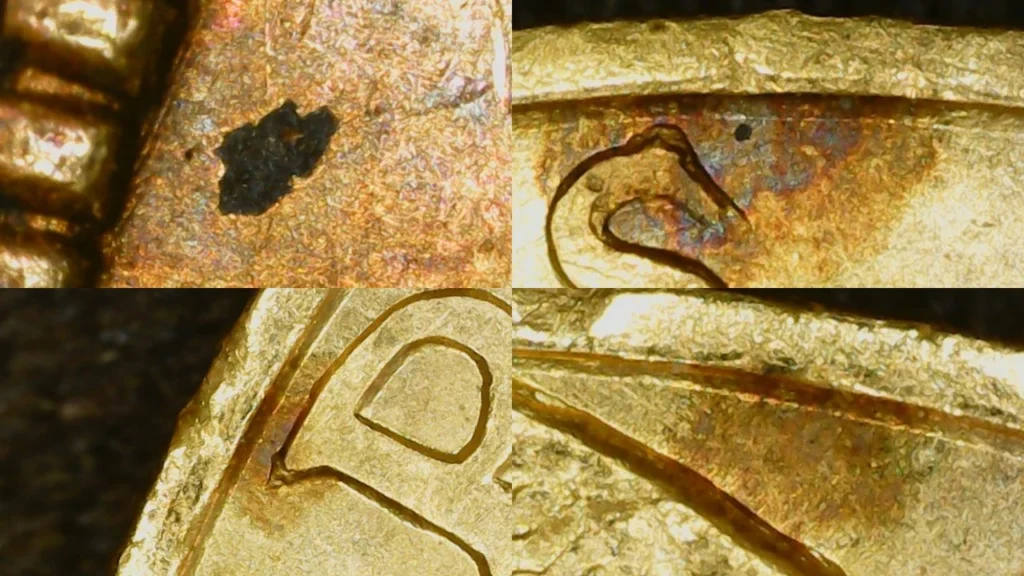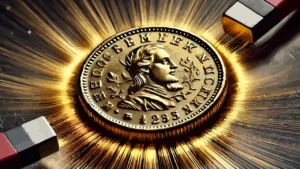Gold coins are symbols of wealth, history, and beauty. However, those who own or collect gold coins may sometimes notice dark red spots on the surface of some coins. This phenomenon can cause concern among collectors and reduce the aesthetic or commercial value of the coin.
In this article, we will explore the main causes of these stains, focusing on the impurities present in metal alloys and the importance of an optimal minting process. We will also see how to prevent the formation of these imperfections and how to deal with them if they already exist.
Contents
#1. Introduction to dark red spots
Dark red spots, often referred to as “copper spots” or “copper spots,” are discolorations that can appear on the surface of gold coins. Although pure gold (24 karat) is extremely resistant to tarnishing and corrosion, most gold coins in circulation are not made from pure gold. To increase their hardness and scratch resistance, gold is often alloyed with other metals, such as copper or silver. This process is essential to producing durable coins, but it also introduces potential vulnerabilities.

Dark red spots are usually caused by the presence of copper in the alloy. Copper, being a more reactive metal than gold, can oxidize over time if exposed to moisture and air. In addition, copper can react with sulfur in the environment to form copper sulfide (Cu₂S), which appears as dark or reddish spots. The silver in the alloy can also react with sulfur to form silver sulfide (Ag₂S), which contributes to the blackening of the surface.
The phenomenon is not always immediately visible: the stains can emerge slowly, even years after minting, especially if the coin is stored in unfavorable environmental conditions, such as environments rich in sulfur vapors or with high humidity. Therefore, it is essential to understand the causes underlying these alterations to prevent future damage and keep the value of the coin intact.ueste alterazioni per prevenire danni futuri e mantenere il valore della moneta intatto.
#2. The role of impurities in spots
One of the main factors that contribute to the formation of dark red spots is the presence of impurities within the metal alloy used in the production of the coin. During the process of melting and alloying the metals, it is essential to use high purity materials to ensure a uniform and defect-free final product. However, even small amounts of impurities can affect the distribution of metals within the alloy.
Copper is often used as a binding metal in gold coins, as it provides greater strength and durability. However, copper is particularly susceptible to chemical reactions with oxygen, moisture, and sulfur compounds in the environment. The formation of copper oxides and sulfides can generate the typical dark red or black spots. Silver, if present in the alloy, can also react with sulfur to form silver sulfide, which causes the surface of the coin to blacken.
Impurities in the alloy, such as traces of iron or lead, can act as catalysts for these chemical reactions, accelerating the oxidation and sulfidation process. Furthermore, during the minting process, non-optimal temperature and pressure conditions can create microzones rich in copper or silver, increasing the risk of localized reactions.
Finally, chemical residues from industrial processes or from sulfur-containing storage materials (such as certain types of paper or plastic) can expose the coin to further risks of oxidation and sulfurization.
#3. The importance of mixing
The mixing of metals during minting is one of the most delicate steps in the production of gold coins. A non-optimal mixing process can lead to an uneven distribution of the elements in the alloy, favoring the formation of dark red spots on the surface of the coin.
To obtain a homogeneous alloy, molten gold is mixed with alloying metals such as copper and silver in precise proportions. However, if the melting temperature is not adequate or if the mixing is not uniform, microzones with a high concentration of copper or silver can be created. These zones, being more reactive, are subject to oxidation and can generate the typical reddish or black spots.
The cooling process after casting is also crucial: too rapid or irregular cooling can cause the formation of micro-cracks and inhomogeneities in the alloy, increasing the risk of surface imperfections. Furthermore, the pressure exerted during the minting phase affects the compactness of the metal: if not correctly calibrated, it can favor the formation of weak points where impurities concentrate.
The presence of sulfur in the production or storage environment can further affect the quality of the coin. Prolonged contact with sulfur vapors or sulfur-containing materials can lead to the formation of metal sulfides on the surface of the coin, accentuating the stains.
#4. Prevention and treatment
Preventing the formation of dark red spots on gold coins requires attention both in the production phase and in the conservation phase. From a production point of view, the use of pure metals and the adoption of rigorous minting processes are essential to reduce the risk of impurities and inhomogeneities in the alloy. Mints that aim for quality adopt strict controls on the materials used and follow standardized procedures to ensure maximum homogeneity of the alloy.
As for storage, it is important to remember that pure gold does not oxidize, but alloying metals such as copper and silver can react with humidity and sulfur in the environment. Therefore, coins should be stored in dry environments, away from sources of humidity, sulfur vapors and materials containing sulfur. The use of protective hermetic capsules or containers with a controlled atmosphere can reduce the risk of oxidation and sulfurization.
If a coin already has dark red spots, it is essential to proceed with caution. Using harsh chemicals or abrasive techniques can permanently damage the coin’s surface and compromise its value. Before taking action, it is always advisable to consult with experts in the field, such as coin restorers or qualified numismatists, who can evaluate the best approach for cleaning.
There are professional stain removal techniques, such as ultrasonic cleaning or the use of specific chemical solutions, but these should only be performed by experienced personnel. In some cases, however, the stains are so embedded in the alloy that their complete removal is impossible without compromising the integrity of the coin.
In conclusion, the presence of dark red spots on gold coins is often linked to chemical reactions involving copper, silver and sulfur, as well as factors of production and conservation. Understanding the causes of this phenomenon allows you to take effective preventive measures and preserve the value and beauty of your coins over time.











Leave a Reply